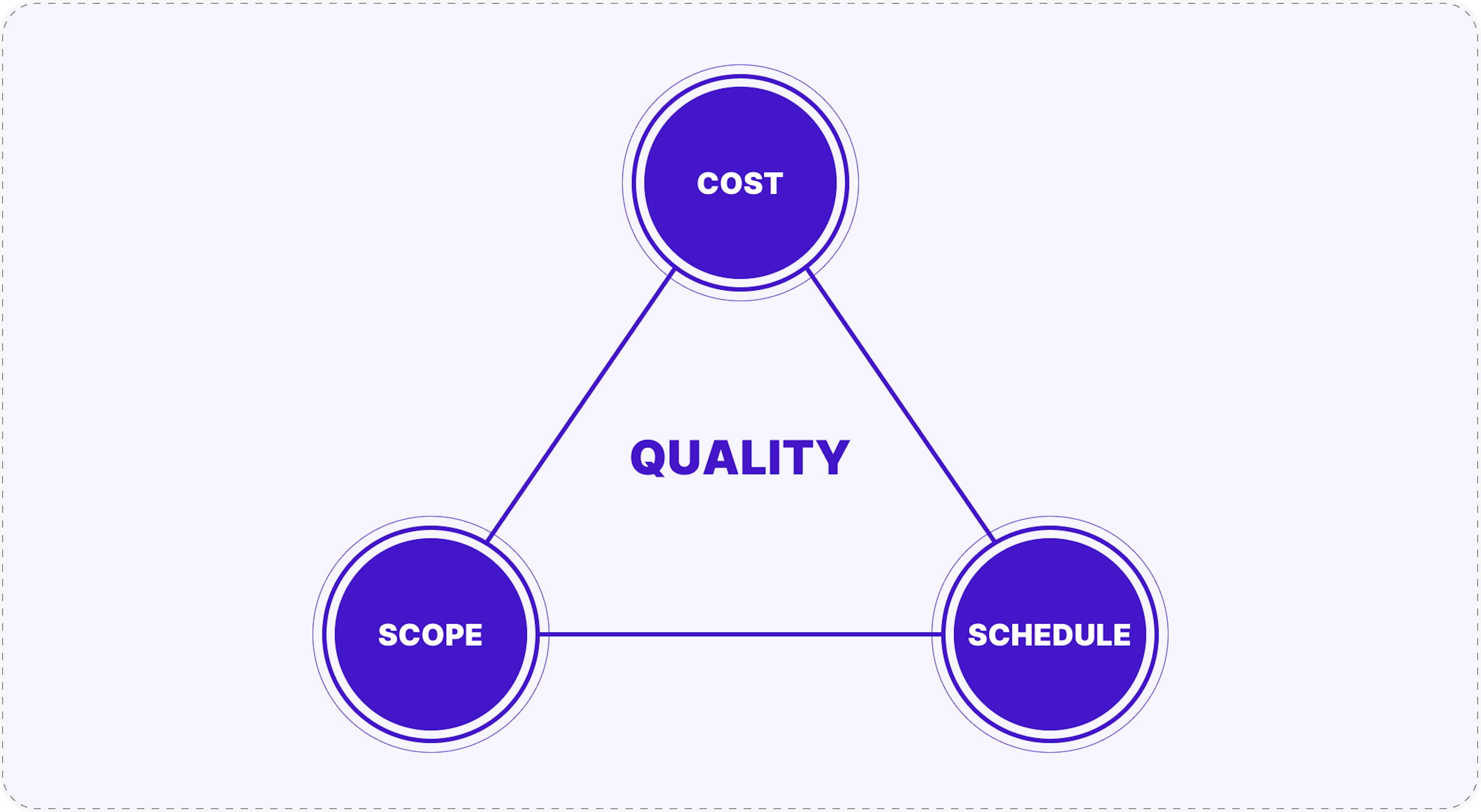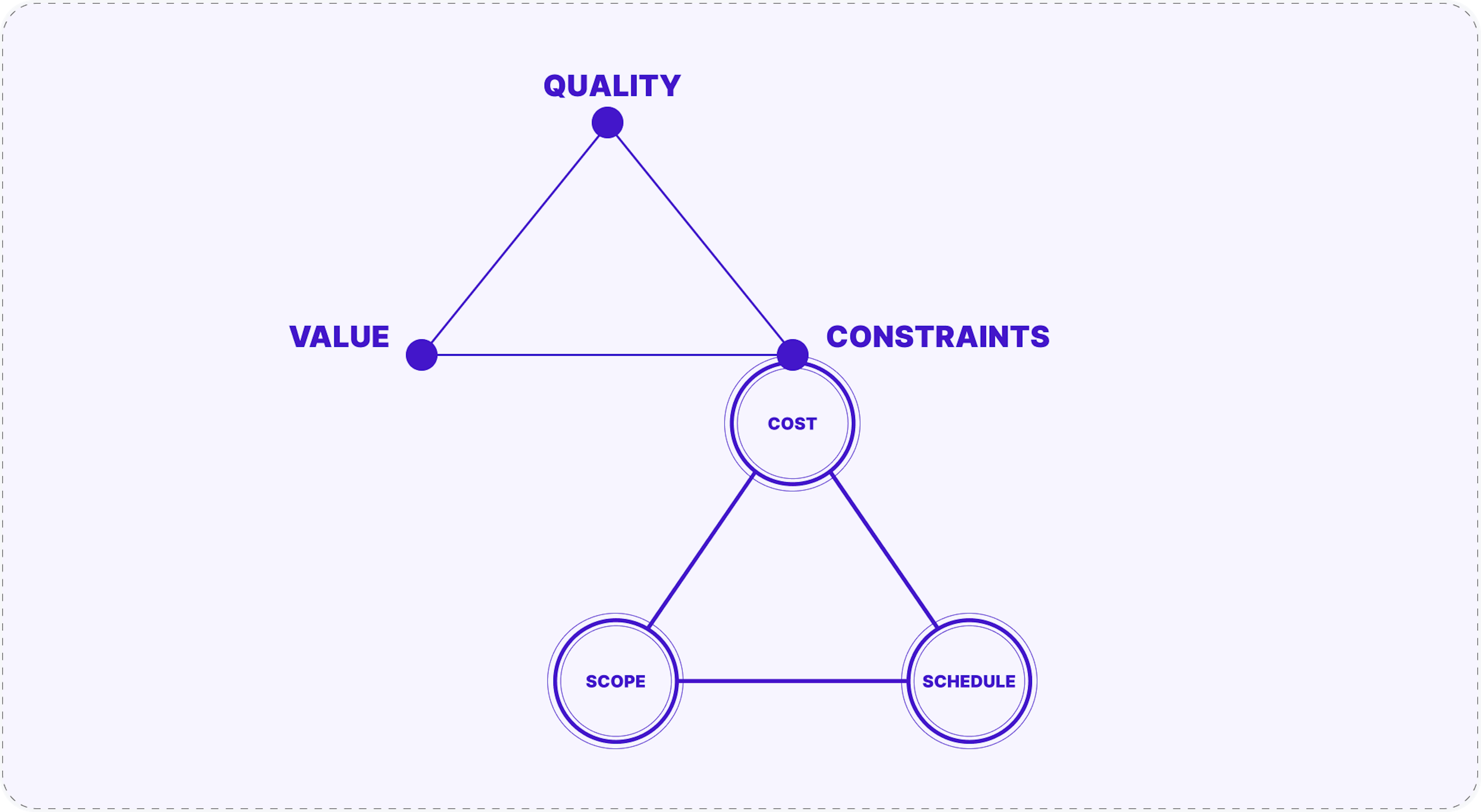The Agile Triangle: Balancing Scope, Time, and Cost in Project Management

The success of a project, or how well it conforms to the expected outcomes, depends on many factors, which in project management are referred to as constraints. These include scope, cost, time, resources, quality, and risks. The classification of the ideal connection between these constraints has been the focus of project management theorists for some time. First, their work led to the creation of the Iron Triangle, which would later serve as the foundation for a new model: the Agile Triangle.
This article will explore the history and concept of these models to provide an understanding of these approaches in terms of their strengths and weaknesses. While both help visualize the delicate balance of project success factors, they are not equally applied to every situation. Likewise, the capabilities of data collection and analysis have changed how they are implemented today.
The Iron Triangle of project management
This model has been around for many years, possibly since the 1950s or earlier, and has been the foundational approach to envisioning the constraints of a project. Quality sits in the middle of the triangle, with three constraints revolving around it: scope, cost, and schedule. To ensure a product, for example, maintains the expected quality, managers need to work within these three constraints and balance them to deliver the product to the client. At times, the manager may need to trade between them, but any changes they make will require compensation in the other constraints to avoid damaging the project's quality.
▪️ Scope: The total amount of work involved in delivering the project
▪️ Cost: The total resources needed for the project
▪️ Schedule: The expected or provided time for delivery
Given the history of this model and its popularity for many years, there are advantages to it as a decision-making framework, including:
- Clear constraints: Defines the project's fixed parameter, time, cost, and scope, which make it easy to plan and track progress.
- Simplicity: Provides a straightforward framework that is simple for stakeholders to understand.
- Accountability: Forces teams to define and stick to commitments, reducing ambiguity.
- Predictability: Useful for projects with well-defined requirements and minimal expected changes.
Here is an example of a project that follows the Iron Triangle:
Iron Triangle example scenario
A company is developing a mobile e-commerce app to be launched in 6 months. Here are the details of the constraints:
- Scope: The app must include features like a product catalog, user accounts, a shopping cart, and payment processing.
- Time: The app must be ready to launch in six months.
- Cost: The project has a fixed budget of $200,000, including salaries, tools, and infrastructure.
Challenges
The team realizes that including advanced analytics or AI-powered recommendations might push the project over budget or delay the release. To stay within the constraints, they prioritize the completion of the core features first and defer advanced features to future updates.
This highlights the Iron Triangle trade-off: changing one constraint (adding features to the scope) affects at least one of the other two (time or cost).
While this approach seems straightforward, it does not account for other factors or accurately portray the relationships between these three constraints and the product's quality. For example, the team above may complete a project in less than six months, remain within their budget, and not change the scope. However, imagine these decisions led to the team members experiencing burnout by the end. Likewise, the Iron Triangle does not offer a means of measuring the client's satisfaction with the result. If some team members quit after the project, and the product does not meet client expectations, it could be difficult to argue the project was "successful."
Other disadvantages of the Iron Triangle model include:
- Rigidity: Leaves little room for adaptation or changes in priorities if new insights arise during the project.
- Quality overlooked: Does not explicitly account for quality, which can suffer if scope, time, or cost are inflexible.
- Value blind: Focuses on delivering output (completing features) rather than outcomes (solving user problems).
- Encourages "deliver at all costs": Teams may sacrifice innovation, usability, or performance to meet deadlines.
- Poor fit for dynamic environments: Assumes predictable requirements, which is unrealistic for iterative projects.
The Iron Triangle was the foundation of project management until an expanded understanding of the constraints within a project appeared alongside an increased emphasis on value.
The Agile Triangle of project management
The overall approach to software development products changed with the creation of the Agile method. Instead of an exclusive focus on the constraints mentioned earlier, this model directed project managers to pay attention to quality and value as well as separate factors that deserve consideration.
▪️ Quality: how reliable the product is, the product's ability to adapt to new regulations, and changes in the desires of customers
▪️ Value: stakeholder satisfaction through feedback
▪️ Constraints: the same scope, cost, and schedule (time) as in the Iron Triangle
Here are some of the reasons teams have switched to this model:
- Focus on value: Prioritizes delivering customer value over rigid adherence to time, cost, or scope constraints.
- Emphasizes quality: Encourages high-quality deliverables through iterative testing, feedback, and continuous improvement.
- Flexibility: Adapts to changing requirements and stakeholder priorities, making it ideal for dynamic projects.
- Collaborative decision-making: Involves stakeholders throughout the project, ensuring alignment with business goals.
- Attention to outcomes: Measures success by customer satisfaction and business impact rather than just meeting predefined constraints.
The example below will illustrate the Agile Triangle in practice:
Agile Triangle example scenario
A startup is building a SaaS platform for task management with a flexible and iterative Agile approach. Their goal is to deliver value, maintain quality, and balance constraints (cost, scope, and time).
- Value: The top priority is delivering a product that users like and find useful. Early user feedback will guide decisions.
- Quality: The software must be reliable, secure, and performant. Automated testing and code reviews are critical.
- Constraints: The budget is $100,000, with a desired initial release in three months.
Execution
Instead of defining a rigid set of features upfront, the team works in sprints. They release a minimum viable product (MVP) after three months with essential task creation, sharing, and progress-tracking features. Based on user feedback, they adjust the backlog and prioritize features like integration with calendars or mobile notifications. As the focus is on outcomes, user satisfaction and business impact, the team will assess the project based on this feedback.
The film industry presents another interesting way to illustrate the difference between these two models, specifically in the output and outcomes of the film Titanic in 1997. The production doubled their planned budget to reach around $200 million, which was the most expensive at the time. While originally expected to take 138 days of filming, the actual number was 160. If viewed through the Iron Triangle, this was not a successful project because it exceeded both costs and scope. However, the Agile Triangle considers the film's value in viewer satisfaction and over $1 billion in revenue to mark it as successful.
In a dynamic environment, such as filming and software development, the Agile Triangle approach encourages flexibility to deliver value and quality with regard to the constraints, even if the scope evolves over time. Compared to the Iron Triangle, this model allows for more flexibility, which is at the heart of the Agile methodology.
However, there are certain disadvantages that deserve consideration:
- Less predictable: Can make budget and timeline estimation challenging for stakeholders expecting fixed plans.
- Scope creep risk: Flexibility may lead to uncontrolled changes, requiring strong prioritization to avoid delays or cost overruns.
- Higher coordination demands: Requires continuous collaboration and frequent reassessment, which can be time-intensive.
- Complexity for stakeholders: Non-technical stakeholders may struggle to adjust to iterative delivery and focus on value rather than outputs.
- Challenging to measure success: Value and quality can be subjective, making it harder to quantify and evaluate progress.
In summary, the Iron Triangle suits traditional, rigid projects with predictable requirements, while the Agile Triangle thrives in environments that demand flexibility, innovation, and customer-focused outcomes. Choosing the right model depends on the project context and goals.
Applying the Agile Triangle today
Advances in technology have adjusted certain aspects of the Agile Triangle, especially those concerned with client and user feedback. Input from stakeholders is a foundational element of the agile approach; however, the balance of using this feedback without affecting quality or constraints is one of the most challenging jobs of project managers. Now, it is becoming more complex.
With real-time data collection and analysis, stakeholders can observe project teams with remote monitoring tools and dashboards. The transparency this approach encourages can help teams increase performance and, in turn, profits. On the other hand, the access stakeholders receive can increase the frequency of their input and distract teams from achieving their targets. It can become more difficult to remain within scope and provide clients with a realistic estimate of the time and resources required for new features. To avoid unnecessary interference and communication, teams can employ platforms that organize data and information into readable dashboards and metrics.
Enji and the Agile Triangle
Transparency is a core principle of Enji.ai, and the platform exists to provide useful data to everyone involved in a project, from front-line employees to managers at all levels and stakeholders, that can boost productivity and help support beneficial communication.
Enji collects project data in the background without affecting the team's work. Whenever an individual or group creates a task and moves it through the necessary stages (or does not), Enji monitors and sends reports to the required roles on the project's progress. Stakeholders receive access to project dashboards and can review updates through messengers in real time to provide feedback that will increase the product's overall value. At the same time, synchronous communication is conducted only when needed because Enji provides succinct summaries of a project's details through Asynchronous Stand-ups and the AI Summarizer.
Enji's analytics track all aspects of the Agile Triangle, and its automation features help ensure teams remain within the cost, scope, and schedule of a project while ensuring its quality and value. Moreover, with historical data, Enji helps leaders provide accurate estimates to clients about the time and other resources required to complete certain features or other tasks.
In addition to the features already mentioned, Enji offers teams an array of tools that maintain focus on the critical goal: creating value through quality.
- Enji PM Agent: A 24-hour AI assistant that answers questions about projects to give leaders insights and concise reports on productivity and progress.
- Code metrics: Objective and comprehensive engineering metrics that managers can use to assess performance and adjust processes to balance constraints.
- Employee Pulse: A tool that uses metrics to assess an individual employee's well-being within a company to detect symptoms of burnout before they affect a project's quality.
- Routine alerts: Customizable reports that appear in team chats to provide updates on progress and other metrics to save time without meetings and manual reporting.
Balance through data
Project managers and other leaders need to balance the constraints and other points of the Agile Triangle to deliver the expected results to clients. This is a challenging task; however, the amount of data teams and individuals produce in their work is a resource managers can use to guide their decisions and planning. With the right analysis and automation, teams can focus on the difficult goal of delivering quality and value, while Enji helps maintain the project within its constraints.




